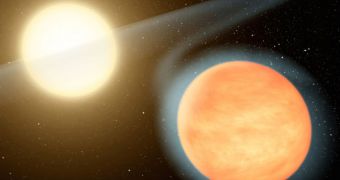Astronomers analyzing the atmosphere of WASP-12b have determined that the exoplanet is home to vast amount of carbon dioxide, even if it's surface is scorching hot. This hints at a larger degree of biodiversity among extrasolar planets than initially thought.
The alien planet is so hot because it lies very close to its parent star. This made it tidally locked to the celestial fireball, which means that it always keeps the same face oriented towards it.
Regardless of this, chemical analysis of the planet has revealed that huge amounts of carbon swirl in the exoplanet's atmosphere, which is the most carbon-rick planet discovered thus far.
As a result of the new findings, astronomers may soon have to rethink their understanding of how planets outside of the solar system form, how diverse these bodies are, and how well might they be suited for supporting life.
Researchers plastically described carbon-rich exoplanets that could be covered in mountains made of graphite or diamond, or some other carbon compound.
“This study shows that there is this extreme diversity out there. Fifteen years or so since the discovery of the first exoplanet, we're just beginning to appreciate how different they can be,” says Nikku Madhusudhan for Space.
The expert, who is now based at the Princeton University, was the lead author of the new investigation, details of which appeared in the December 8 online issue of the esteemed journal Nature.
WASP-12b is not a friendly place. Temperature on the side permanently oriented towards its parent star can reach as much as 4,200 degrees Fahrenheit (2,316 degrees Celsius), which means that it can easily melt steel.
The exoplanet is located some 1,200 light-years away from Earth, and orbits the star at about 2 percent the distance our planet is from the Sun. This is why the system is tidally locked.
The same thing happens between the Earth and the Moon due to their proximity. Our natural satellite always keeps the same face oriented towards the planet.
But, unlike our corner of the Universe, WASP-12b is a very large planet. When discovered back in 2008, researchers determined that it has about 1.4 Jupiter masses.
Chemical analyses of the planet were conducted using data from the NASA Spitzer Space Telescope and the Canada-France-Hawaii Telescope, in Hawaii.

 14 DAY TRIAL //
14 DAY TRIAL //